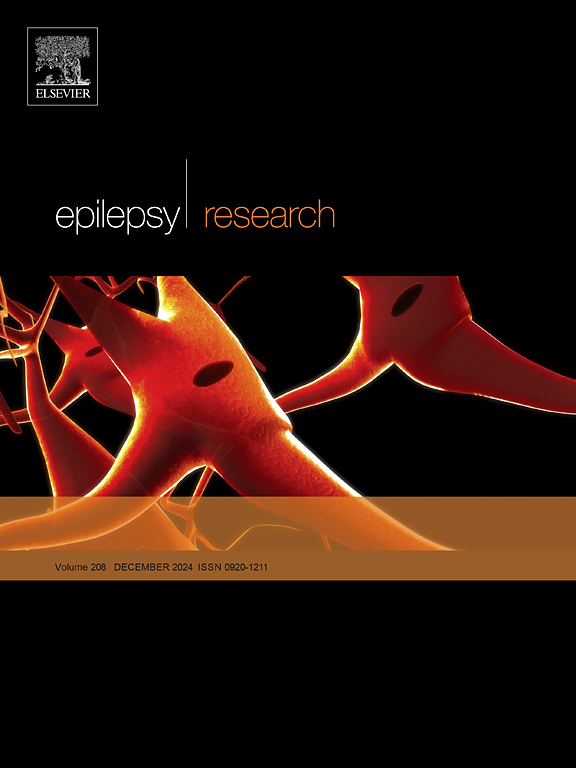Co-morbid seizures in frontotemporal dementia: What do they tell us?
IF 2
4区 医学
Q3 CLINICAL NEUROLOGY
引用次数: 0
Abstract
Objectives
Comorbid seizures occur in 2–11 % of frontotemporal dementia(FTD). Despite the high risk for seizures, the risk factors, clinical characteristics, and seizure outcomes in FTD patients with comorbid seizures remain understudied.
Methods
All patients who presented to our hospital from 5/1/2011–4/30/2024 with a clinical diagnosis of FTD were included and subclassified into behavioral-variant FTD(bvFTD), sematic-variant-primary-progressive-aphasia(svPPA), or non-fluent-primary-progressive-aphasia(nfPPA). Demographics, comorbidities, dementia characteristics, and seizure characteristics were obtained from electronic medical records. Patients were classified into those with(FTD+SZ) or without(FTD-SZ) clinically-diagnosed seizures. Seizure outcome was categorized as uncontrolled, controlled on anti-seizure-medications(ASMs), or self-resolving if resolved without ASMs. Data were analyzed using Pearson’s Chi-squared, Fisher Exact, or t-tests.
Results
Of 317 FTD patients(average age of dementia onset=64.18+9.07years,46.37 % female]), 24(7.6 %) reported seizures. FTD+SZ were more likely to have anxiety(FTD+SZ=7(29.17 %),FTD-SZ= 35(11.95 %),p = 0.0392).Traumatic brain injury(TBI) was the only risk factor for seizures(FTD+SZ=6(25 %),FTD-SZ= 18(6 %),p < 0.001). BvFTD was the most common subtype in FTD+SZ(54.17 %). Focal seizures were more common(50 %) than generalized (29.17 %), with temporal-lobe epilepsy(TLE) being the most common subtype of focal seizures(42 %). Levetiracetam was the most frequently used ASM(38.1 %). Seizures had a favorable prognosis, with 87.5 % achieving seizure control through ASMs, and seizures self-resolving in the rest. FTD+SZ were more likely to be older at death(FTD+SZ=78.63years,FTD-SZ=71.37,p = 0.03966).
Significance
The prevalence of comorbid seizures in FTD at our single-center is 7.6 %. They were most common in bvFTD, primarily focal, with TLE as the predominant subtype. Anxiety was more prevalent with comorbid seizures. Most achieved seizure control on ASMs. FTD+SZ were older at death. These findings address a critical gap, guiding diagnosis, management, and future research.
额颞叶痴呆的共病性癫痫发作:它们告诉我们什么?
目的:在额颞叶痴呆(FTD)患者中,2 - 11% %发生癫痫共病。尽管癫痫发作的风险很高,但合并癫痫发作的FTD患者的危险因素、临床特征和癫痫结局仍未得到充分研究。方法纳入2011年5月1日至2024年4月30日期间所有临床诊断为FTD的患者,并将其分为行为变异性FTD(bvFTD)、语义变异性原发进行性失语症(svPPA)和非流利性原发进行性失语症(nfPPA)。统计数据、合并症、痴呆特征和癫痫发作特征从电子病历中获得。患者被分为有(FTD+SZ)和没有(FTD-SZ)临床诊断癫痫发作。癫痫发作结果分为不受控制,抗癫痫药物(asm)控制,或自行解决(如果没有asm)。数据分析采用皮尔逊卡方检验、Fisher精确检验或t检验。结果317例FTD患者(平均痴呆发病年龄64.18+9.07岁,女性46.37 %)中,24例(7.6 %)报告癫痫发作。FTD+SZ更容易出现焦虑(FTD+SZ=7(29.17 %),FTD-SZ= 35(11.95 %),p = 0.0392)。创伤性脑损伤(TBI)是癫痫发作的唯一危险因素(FTD+SZ=6(25 %),FTD-SZ= 18(6 %),p <; 0.001)。BvFTD是FTD+SZ中最常见的亚型(54.17 %)。局灶性癫痫发作(50 %)比全面性癫痫发作(29.17 %)更为常见,其中颞叶癫痫(TLE)是最常见的局灶性癫痫发作亚型(42 %)。左乙拉西坦是最常用的ASM(38.1 %)。癫痫发作预后良好,87.5% %的患者通过抗痉挛药物获得癫痫发作控制,其余患者癫痫发作自行消退。FTD+SZ组死亡年龄更大(FTD+SZ=78.63岁,FTD-SZ=71.37,p = 0.03966)。意义:在我们的单中心研究中,FTD共病性癫痫的患病率为7.6% %。它们在bvFTD中最常见,主要是局灶性的,以TLE为主要亚型。焦虑在共病发作中更为普遍。大多数患者在抗痉挛药物治疗中获得了癫痫控制。FTD+SZ在死亡时年龄较大。这些发现解决了一个关键的差距,指导诊断、管理和未来的研究。
本文章由计算机程序翻译,如有差异,请以英文原文为准。
求助全文
约1分钟内获得全文
求助全文
来源期刊

Epilepsy Research
医学-临床神经学
CiteScore
0.10
自引率
4.50%
发文量
143
审稿时长
62 days
期刊介绍:
Epilepsy Research provides for publication of high quality articles in both basic and clinical epilepsy research, with a special emphasis on translational research that ultimately relates to epilepsy as a human condition. The journal is intended to provide a forum for reporting the best and most rigorous epilepsy research from all disciplines ranging from biophysics and molecular biology to epidemiological and psychosocial research. As such the journal will publish original papers relevant to epilepsy from any scientific discipline and also studies of a multidisciplinary nature. Clinical and experimental research papers adopting fresh conceptual approaches to the study of epilepsy and its treatment are encouraged. The overriding criteria for publication are novelty, significant clinical or experimental relevance, and interest to a multidisciplinary audience in the broad arena of epilepsy. Review articles focused on any topic of epilepsy research will also be considered, but only if they present an exceptionally clear synthesis of current knowledge and future directions of a research area, based on a critical assessment of the available data or on hypotheses that are likely to stimulate more critical thinking and further advances in an area of epilepsy research.
 求助内容:
求助内容: 应助结果提醒方式:
应助结果提醒方式:


